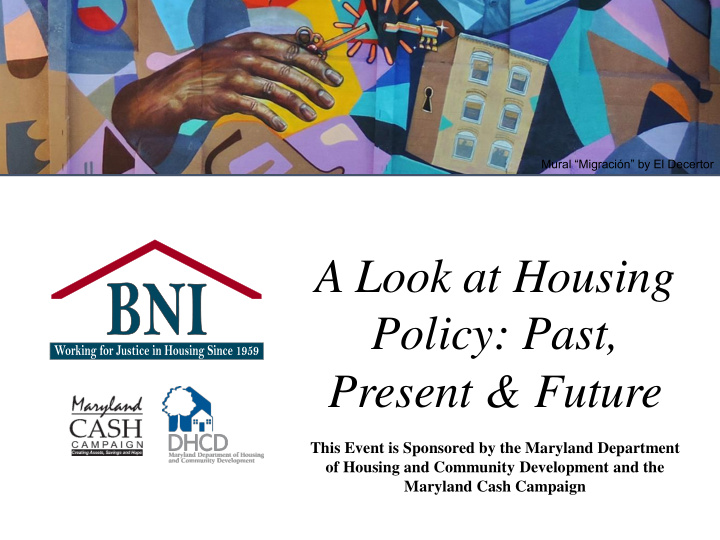



Mural “Migración” by El Decertor A Look at Housing Policy: Past, Present & Future This Event is Sponsored by the Maryland Department of Housing and Community Development and the Maryland Cash Campaign
“Where you live affects so much in life — your access to transportation, employment opportunities , decent health care, and, most important, good schools,” [and] “Access to good schools means a higher chance of attending college, which can lead to higher- paying employment, more wealth accumulation , and ultimately, more choices of where to live and start a family” – Richard Kahlenberg
But what if you were not given an equal opportunity to choose where you live?
Presentation Overview 1. Housing Discrimination & Segregation Today 2. The Roots of Racial Segregation in Housing 3. Civil Rights & Housing Rights 4. The Future of Fair & Affordable Housing
1. Housing Discrimination & Segregation Today
Source: National Fair Housing Alliance
Source: National Fair Housing Alliance
The intersection of segregation and housing discrimination • Race accounts for 19% of reported housing complaints in the U.S . in 2016 according to the National Fair Housing Alliance • Approximately 18% of housing complaints to BNI were discrimination based on race • “Although declining, discrimination – in sales, rentals, lending, and insurance - remains common and is an important factor contributing to racial housing segregation ,” (Farley, 2015)
The intersection of segregation and housing discrimination • According to Maryland Residential Segregation Index (2010-2014) County Health Rankings, the overall segregation score for Maryland is 63, 63 on a scale where 0 is complete integration and 100 is complete segregation. Source: http://www.countyhealthrankings.org/app/maryland/2016/measure/factors/141/data
2. The roots of racial segregation in housing
Federal Fair Housing Law • The Civil Rights Act of 1866 • "all persons born in the United States," with the exception of American Indians, were "hereby declared to be citizens of the United States." The legislation granted all citizens the “full and equal benefit of all laws and proceedings for the security of person and property.” • But were all citizens given the full and equal benefit of all laws in 1866?
The Color of Law by Richard Rothstein “Racial segregation in housing was not merely a project of southerners in the former slaveholding Confederacy. It was a nationwide project of the federal government …Our system of official segregation was not the result of a single law that consigned African Americans to designated neighborhoods. Rather scores of racially explicit laws, regulations, and government practices …Private discrimination also played a role, but it would have been considerably less effective had it not been embraced and reinforced by the government.”
Policies that enabled segregation • Redlining • Steering • Blockbusting • Restrictive covenants • Veterans Administration and the Federal Housing Administration • Public Housing Source: https://dsl.richmond.edu/panorama/redlining • Zoning
3. Civil Rights & Housing Rights
https://www.youtube.com/watch?v=0EKo5rBBzpI&t=46s
4. The Future of Fair & Affordable Housing
The Color of Law by Richard Rothstein “The core argument of this book is that African Americans were unconstitutionally denied the means and the right to integration in middle-class neighborhoods, and because this denial was state-sponsored, the nation is obligated to remedy it.”
Policies for the future In order to eliminate segregation in housing: • Prioritize housing and affordable housing in comprehensive plans • Create more housing opportunities for residents with a wide variety of incomes in low-density areas • “ We should re-examine and revise industry standards for appraisals, recognizing that today’s standards inherited a subjective standard of a “desirable urban structure” that was constructed in the early 1900s, when racial zoning was the norm,” ( Olinger & Capatosto, 2017).
Personal practices for the future • “Research shows that the best way to remedy the effect of our implicit bias is to immerse ourselves in opportunities to make positive connections with a diverse group of people and experience situations that may put us outside our comfort zone. In this way, we can all begin to chip away at our personal ingrained implicit biases,” (Olinger & Capatosto, 2017).
What does discrimination in housing look like? • Refusing to rent or sell housing • Refusing to negotiate for housing • Making housing unavailable • Falsely denying that housing is available for inspections • Set different terms, conditions or privileges for sale or rental of a dwelling. • Provide different housing services or facilities • Retaliation
What does discrimination in housing look like? • Refusal to make a mortgage loan, or imposing different terms or conditions on a loan, such as different interest rates, points or fees • Discrimination in appraising property • Refusing to provide homeowners insurance coverage, or discrimination in the terms or conditions of coverage • Steering • Redlining • Blockbusting • Discriminatory advertising
If housing discrimination is encountered: • Complaints of housing discrimination based on a federal, state, or local protected class should be directed to BNI, Fair Housing Department, M-F 9a-5p 410-243-4400 • Provide a complete, factual account of a housing transaction that claims discrimination based on membership of a federally or locally protected class. • Give full details, no matter how small. Document names, dates, addresses. Attempt to provide a witness. Request written correspondence.
Become a fair housing tester • By becoming a fair housing tester with BNI you can help uncover discrimination in housing • Sign up and attend a training (next training is scheduled for October) https://www.youtube.com/watch?v=P9lNdF Q_keI&list=LL_8eKyaIoetvinf--C8olWQ
Questions?
Thank You! • Office Location • 2530 North Charles Street, Suite 200, Baltimore, MD 21218 • Open 9 – 5, weekdays • Purchases only, no walk-in counseling • Website • www.bni-maryland.org • Email your tenant-landlord questions to a counselor! • Tenant-Landlord Hotline 410-243-6007 or 1-800-487-6007 • Fair Housing Department 410-243-4400 • Administrative Line 410-243-4468
Recommend
More recommend